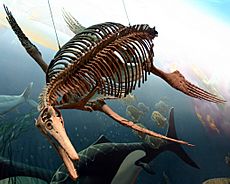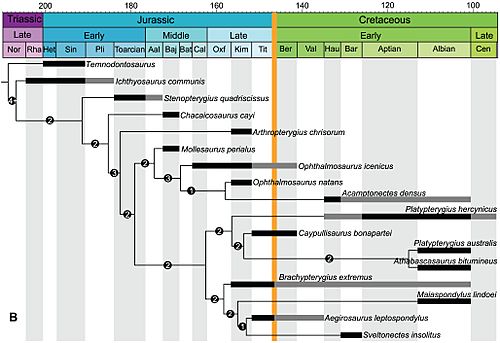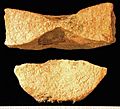Ichthyosaur facts for kids
Quick facts for kids IchthyosauriaTemporal range: Lower Triassic – Upper Cretaceous
|
|
|---|---|
 |
|
| Dolichorhynchops | |
| Scientific classification | |
| Kingdom: | |
| Phylum: | |
| Class: | |
| Subclass: | |
| Superorder: |
†Ichthyopterygia
|
| Order: |
†Ichthyosauria
Blainville, 1835
|
| Families | |
|
Triassic forms:
Jurassic & Cretaceous forms
|
|

Ichthyosaurs were a group of extinct marine reptiles that lived during the Mesozoic era. They looked a lot like modern dolphins or fast-swimming tuna fish. This is an example of convergent evolution, where different animals develop similar body shapes because they live in similar environments.
Ichthyosaur fossils have been found in ocean rocks from the earliest Triassic period all the way to the Cretaceous period. Early types, sometimes called proto-ichthyosaurs, are part of a larger group called Ichthyopterygia. After some early forms like Mixosaurus and Cymbospondylus, most ichthyosaurs had the same dolphin-like body shape. Californosaurus was one of the first to look like a dolphin.
Even though single ichthyosaur vertebrae (backbones) are quite common, the first complete fossil showing what an ichthyosaur looked like was found by Mary Anning (1799–1847) and her brother Joseph. Mary Anning was a famous early British fossil collector and paleontologist. Many of the fossils she found are now in the Natural History Museum in London.
Contents
Discovering Ichthyosaurs
The name Ichthyosaurus was first used in 1699 for fossil pieces found in Wales. The first fossil backbones were written about in 1708. But the first full ichthyosaur fossil was found in 1811 by Mary Anning in Lyme Regis, along the Jurassic Coast. She later found three more types of ichthyosaurs.
Mary Anning's Big Find
Mary Anning made her first big discovery when she was only twelve years old, shortly after her father passed away. In 1810, her brother Joseph found what he thought was a crocodile skull. But the rest of the animal was missing. Mary kept looking. A year later, a storm washed away part of the cliff, revealing more of the skeleton. This creature was about 17 feet (5.2 meters) long. With a little help from local quarrymen, she was able to dig it out of the cliff.
How Big Were They?
Scientists have estimated the weight of ichthyosaurs. A Stenopterygius that was about 2.4 meters (7.9 feet) long weighed around 163–168 kilograms (360–370 pounds). A larger Ophthalmosaurus icenicus, about 4 meters (13 feet) long, weighed 930–950 kilograms (2,050–2,090 pounds). That's like a small car!
Warm-Blooded or Cold-Blooded?
Scientists have often wondered if ancient reptiles like ichthyosaurs were warm-blooded (like mammals and birds) or cold-blooded (like modern reptiles). Researchers at the University of Plymouth studied many animals that dive and hold their breath, from insects to whales. They found that bigger animals can hold their breath longer than smaller ones because they can store more oxygen. This difference was much greater for warm-blooded animals.
They suggested this might be why modern whales grew so large. Based on their large size, scientists think ichthyosaurs were more likely to be warm-blooded, just like whales.
How Ichthyosaurs Evolved
Biologist Stephen Jay Gould loved ichthyosaurs as a great example of convergent evolution. This is when different species develop similar traits because they adapt to similar environments, not because they share a common ancestor.
Ichthyosaurs were reptiles that came from land animals. But they became so much like fish that they even developed a dorsal fin (on their back) and a tail fin. These fins were in the perfect spot and designed perfectly for swimming in water. This is amazing because their land-dwelling ancestors had no such fins.
Amazing Eyes
Ichthyosaurs had very large eyes compared to their body size. This suggests they hunted by sight, even in dim water or at night. In fact, ichthyosaurs hold a record for eye size! The largest eye ever found for a vertebrate (an animal with a backbone) was 264 millimeters (about 10.4 inches) in diameter. This eye belonged to the species Temnodontosaurus platyodon. Only the colossal squid has larger eyes.
The eyes of ichthyosaurs were protected by sclerotic rings. These are circular bony plates inside the outer edges of the eye. They helped support the large eyes. These rings are often well-preserved in fossil ichthyosaur skulls.
Fins and Body Shape
At first, scientists found it hard to understand the downward-pointing tail bones of ichthyosaurs. But later in the 1800s, an amazing discovery was made. Some fossils of Mixosaurus and Stenopterygius were found perfectly preserved in black mudstones in Germany. These fossils were so well-preserved that the outline of the body could be seen as a thin carbon film.
Even though the soft parts of the animals had long since rotted away, they left their imprint. For the first time, scientists could clearly see that the ichthyosaur's tail was shaped like a fish's tail. And on its back, like a shark, it had a dorsal fin.
Reproduction: Live Birth
Scientists always thought ichthyosaurs gave live birth. This is because their paddle-like flippers would have made it impossible for them to move onto land to lay eggs, like turtles do. Even though they were reptiles, their eggs developed inside the mother, and they were born alive in the water.
More evidence came from the early Jurassic period in Germany. Several fossils clearly show baby ichthyosaurs inside the mother's rib cage. Other fossils show young ichthyosaurs actually being born. They came out tail first. It's likely that some problem during birth caused both the mother and babies to die together.
A recent study of the earliest ichthyosaur, Chaohusaurus, from the Lower Triassic period, showed an early example of live birth. What was surprising was a baby close to coming out head-first. This suggests that live birth might have first evolved in ichthyosaurs when they were still living on land. Then, later, they adapted to giving birth tail-first in the water, which is safer for water-dwelling animals like whales and sea cows.
Why Ichthyosaurs Disappeared
Ichthyosaurs became extinct during the Upper Cretaceous period, about 30 million years before the famous dinosaur extinction event. At that time, there was an ocean anoxic event. This means the deeper parts of the oceans lost all their oxygen and became poisoned by harmful gases. As life died off in the lower parts of the sea, the animals at the top of the food chain, like the last pliosaurs and ichthyosaurs, also died out.
Ichthyosaur numbers had been going down for a while. They were not as powerful as they had been in the Upper Triassic and Lower Jurassic. By the middle Jurassic, it was thought that all remaining ichthyosaurs belonged to just one group, the Ophthalmosauridae. By the Cretaceous, only three types were thought to have survived. For a long time, scientists believed only one type, Platypterygius, was left when the anoxic event happened.
However, a recent study looked at fossils in European museums. This study found evidence for four different types of ichthyosaurs just a few million years before they went extinct. These different types ate different kinds of food:
- Platypterygius: a top predator (hunter)
- Sisteronia: ate soft and small prey
- Cetarthrosaurus: a generalist (ate many different things)
- An unknown Ophthalmosaur: also a generalist
This means there was still a good variety of ichthyosaurs just before they disappeared. They might have survived right up until the ocean anoxic event.
It's true that ichthyosaurs had fewer types than before. By the Cretaceous period, they had more competitors than in the Triassic. Their prey (the animals they hunted) also became faster and harder to catch. New types of fast-swimming fish called teleosts appeared. These fish were both new prey and new competitors. From what we know now, the ocean anoxic event was the final reason for the last ichthyosaurs to die out.
After the ichthyosaurs and pliosaurs disappeared, giant mosasaurs took their place in the ocean. Mosasaurs were probably ambush hunters, meaning they waited for prey to come to them. This hunting style seemed to be very successful.
Images for kids
-
Ichthyosaur and Plesiosaur by Édouard Riou, 1863. (This old picture of a plesiosaur lifting its head is not accurate and physically impossible.)
-
"Professor Ichthyosaurus" shows his students the skull of an extinct human. This is a funny drawing of Charles Lyell by Henry De la Beche (1830).
-
Hawkins' specimens are still important displays at the Natural History Museum.
-
Typical fossils from Holzmaden, Germany: an adult and young Stenopterygius quadriscissus.
-
Precious opal has replaced the ichthyosaur backbone in this display at the South Australian Museum.
-
Shonisaurus popularis
-
A drawing of Platypterygius kiprijanovi from the Albian-Cenomanian period in Russia.
-
A computer-generated image of Ichthyosaurus communis.
-
The skull of Temnodontosaurus platyodon has the typical ichthyosaur shape with a long snout and large eye sockets.
-
An ichthyosaur vertebra from the Sundance Formation (Jurassic) in Wyoming. Notice the hourglass shape. (Scale in mm.)
-
An ichthyosaur 'paddle' (flipper) at the Charmouth Heritage Coast Centre.
-
In this arm of Ophthalmosaurus icenius, an extra row of bones has grown in the upper part of the flipper.
-
An ichthyosaur coprolith (fossilized poop).
-
Temnodontosaurus acutirostris with ammonoids.
-
Even though they are quite big, the flippers of the Amazon river dolphin are mostly used for steering.
See also
 In Spanish: Ictiosaurios para niños
In Spanish: Ictiosaurios para niños


























